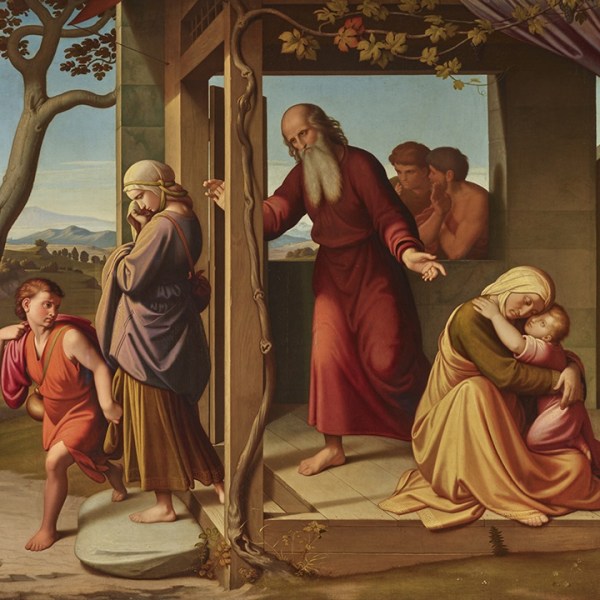Johann Friedrich Overbeck ‘s The Banishment of Hagar purchased by The Metropolitan Museum of Art
We are delighted to announce the sale of Johann Friedrich Overbeck’s The Banishment of Hagar to The Metropolitan Museum of Art in New York.
It goes without saying that we are deeply honored that Overbeck’s masterpiece will soon be on public display at The Metropolitan Museum of Art. The Banishment of Hagar was the centerpiece of our recent gallery exhibition, The Nazarenes (November 2023 – January 2024). Founded in the early years of the nineteenth century by Johann Friedrich Overbeck and fellow artist, Franz Pforr, the Nazarene group became the first anti-academic, anti-establishment movement in 19th century European art. It has been very rewarding to see such a positive response to our innovative show and the acquisition of Overbeck’s painting by The Met confirms the significance of this important movement in art history.
About Overbeck’s The Banishment of Hagar
At the height of his fame and artistic power, Johann Friedrich Overbeck turned to a theme of immense popularity in 19thcentury Europe: the expulsion of Hagar and her son Ishmael from the house of Abraham (Genesis 21:14). The finished canvas would be exceptional for several reason. For one, it is one of his few biblical histories executed in oil. On the other, it lives off a poetic mood hardly found in any other painting by the artist. At the same time, the canvas embodies some of Overbeck’s most cherished characteristics, such as a calm, contemplative interiority triumphant over the intense emotional charge of the biblical source.
The expulsion seems to take place almost silently, the figures animated by a peculiar devotion, the biblical landscape in the background glowing in an expert old-masterly sfumato. With the picture’s future destination in mind, the private collection of a wealthy Hamburg client, Overbeck settled on a typical gallery format, skillfully using the transverse rectangle to tell the tale via the figures’ arrangement and gestures. Overbeck set a powerful tone of resistance, to fate and the viewer’s gaze alike, by having Hagar and Ishmael move to the left, away from the house, and thus against our reading direction. In a countermove, the same play with our conventional reading direction assumes a conciliatory tone as it continues in the gesture of Abraham’s left arm. The patriarch points to his wife, Sarah, crouching on the ground with Isaac, the boy she had born at ninety years old, in her arms. Having just created a clear contrast of the two groups, Overbeck, a Catholic convert himself, now transforms the Romantic program of the Lukasbund’s early days into a fundamental confessional decision. Hagar’s banishment becomes a typological image in which the replacement of the Old by the New Covenant is at stake. The symbolism of plants—the fig tree as a sign for the nation of Israel, the vine a symbol of Christ’s Passion—articulate this Supersessionist program as clearly as the allusion to a Madonna with Child in the image of Sarah and her son. Probably based on the scene’s (re)interpretation by Paul (Galatians 4:21-24), Overbeck thus presented the story of Hagar, Sarah, Abraham, and their children as a parable of the two testaments of Ecclesia and Synagogue.
The canvas, without question a major work not only vis-à-vis Overbeck’s production, but late Romantic painting as well, had a long gestation time. Its origins go all the way back to a studio visit in 1830 by Martin Johann Jenisch the Younger (1793-1857), a wealthy merchant and influential senator in Hamburg. The previous year, Jenisch and his wife had embarked on the Grand Tour, mandatory for all of Europe’s High Society, with their minds set less on education but desirable purchases. Naturally, a work by a leading Nazarene could not be missing from their list, and as soon as they reached Rome, the couple approached, predictably, Overbeck. For once, the painter happily accepted the commission, but things soon got off to a rocky start. Overbeck refused to send the senator a compositional sketch because, as he told Jenisch, foreign judgment would disturb and inhibit him. In 1834, the cartoon was finally ready and exhibited two years later at the biannual exhibition of the Berlin Academy; but the picture itself was still a long time coming. Only when Jenisch returned a second time to Rome in 1838 and reiterated his desire (and claim), did Overbeck return to Hagar’s Banishment and finally completed it in 1841. Once in Hamburg, the canvas immediately assumed a place of pride among the over 100 paintings which by then adorned the Jenischs’s newly built country house, a marvel of Neoclassical architecture with an exquisite, rather Romantic view over the Elbe.
One final word: The Banishment of Hagar is unquestionably one of the most important works by Johann Friedrich Overbeck to have appeared on the art market for decades. Paintings by Overbeck are extremely rare, as he executed only a few works in oil and most of these are now in the permanent collections of German museums. Not only did The Banishment of Hagar remain in the same collection, started by Jenisch, for more than 150 years. This collection itself is among the few private painting collections amassed in 19th-century Germany that have come down to us mostly intact. As such, The Banishment of Hagar is among the most unique, and perhaps among the rarest, pieces of High Romanticism to be offered for sale in the 21st century.
This note was written by Cordula Grewe, author of The Nazarenes: Romantic Avant-Garde and the Art of the Concept.

